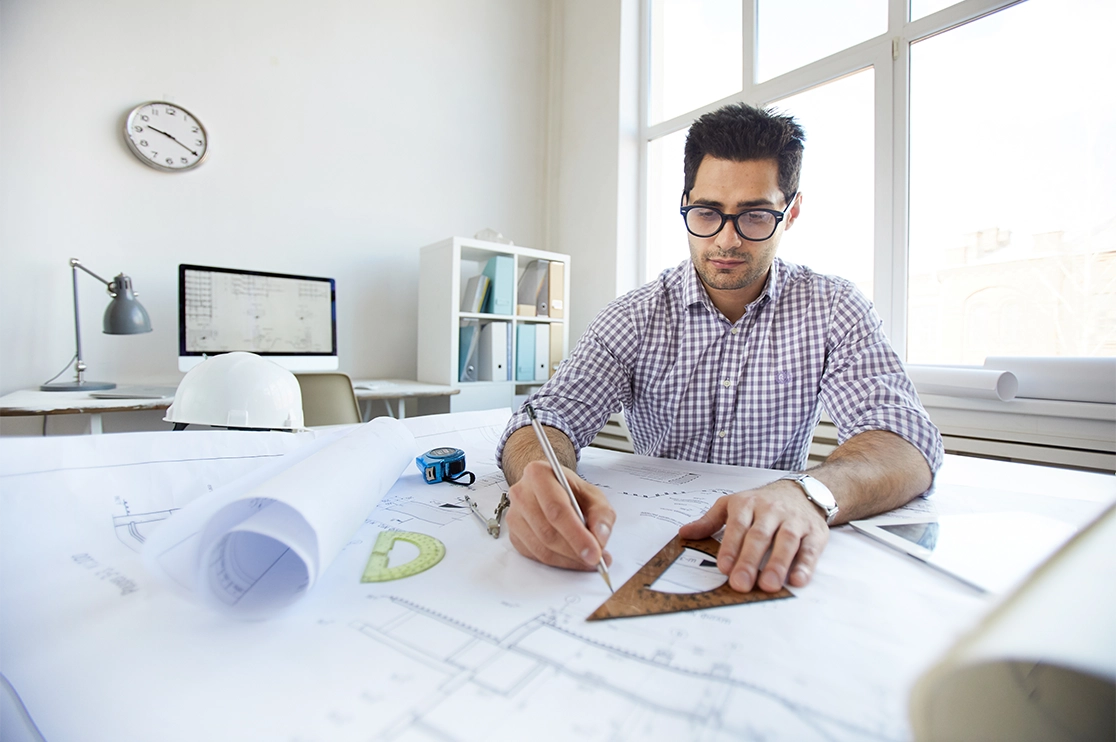Architect Collaboration Tips for Working with Engineers and Contractors
Architect Collaboration Tips for Working with Engineers and Contractors
Blog Article
Understanding the Diverse Career Paths Available for Aspiring Architect
As a hopeful Architect, you have a globe of profession paths waiting for you. Whether you're attracted to traditional style or the nuances of lasting design, there's a specific niche that aligns with your rate of interests.
Typical Design: Creating Structures and buildings
Conventional design concentrates on making structures and structures that blend functionality with aesthetic charm. As you explore this field, you'll value the intricate balance in between form and purpose. You'll find out to draw inspiration from historical styles, including elements like balance, products, and craftsmanship. Your designs can show social heritage, showcasing local customs while fulfilling modern-day needs.
You'll develop skills in composing, model-making, and website evaluation, allowing you to picture and interact your ideas efficiently. Engaging with customers, you'll require to comprehend their vision and translate it right into practical styles.
In addition, developing codes and sustainability practices are important in your job, guaranteeing your structures are environmentally pleasant and risk-free. As you grow in your job, you'll discover opportunities in household, industrial, or even reconstruction jobs, each offering unique obstacles. Accepting traditional architecture leads the method for a fulfilling occupation that admires the past while forming the future.
Urban Preparation: Shaping Areas and Public Spaces
As a hopeful Architect, you can play an essential duty as a city planner, transforming how communities engage and function. By using community interaction strategies, you'll ensure that residents have a voice in forming their setting. Plus, incorporating lasting style principles will certainly assist create areas that not just meet today's demands but additionally secure the future.
Role of Urban Planners
While numerous may think of architects as the sole visionaries behind structures, city organizers play a necessary duty in forming the wider landscape of communities and public areas. By working together with numerous stakeholders, you'll assist make parks, transport systems, and domestic areas that advertise social communication and access. Your expertise in spatial layout and neighborhood dynamics permits you to imagine future growth while maintaining social heritage.
Community Involvement Methods
Reliable community engagement techniques are crucial for city organizers to guarantee that the voices of residents are heard and valued in the planning process. To promote significant dialogue, you must focus on open discussion forums and workshops where community members can express their ideas and issues. By actively listening and including feedback, you'll create spaces that reflect the area's demands, inevitably leading to even more effective and lasting urban environments.
Sustainable Design Concepts
When making city rooms, including lasting style principles is critical for developing settings that prosper both environmentally and socially. You need to begin by concentrating on energy effectiveness, using materials that reduce waste and advertise recycling. Take into consideration incorporating eco-friendly rooms, like yards and parks, to enhance biodiversity and improve air high quality. Promoting walkability and public transportation can minimize dependence on automobiles, fostering a much healthier neighborhood.
Designing with water conservation in mind is likewise key-- think of rainfall yards and permeable surface areas to take care of stormwater. Entailing community members throughout the planning process assurances that the rooms you create fulfill their needs and motivate social communication. By embracing these concepts, you'll add to lively, sustainable metropolitan landscapes that profit everyone.

Landscape Style: Developing Sustainable Outdoor Settings
As you explore landscape architecture, you'll find important design concepts that create beautiful and useful outside spaces. Lasting practices play a vital function in making certain these atmospheres thrive while decreasing ecological influence. Plus, you'll locate a range of career possibilities that allow you to make a genuine difference in exactly how individuals communicate with nature.
Layout Principles in Landscape
Comprehending layout principles in landscape design is important for producing lasting outdoor atmospheres that integrate with nature. You'll need to consider components like equilibrium, scale, and proportion to guarantee your styles really feel natural and inviting. Integrating indigenous plants not just enhances biodiversity however likewise lowers water usage, making your landscape resilient. Consider the circulation of space and how people engage with it; paths and seating locations should invite expedition and leisure. Furthermore, take note of seasonal adjustments, designing with materials that match the environments year-round (Architect). By prioritizing sustainability and looks, you can create outside rooms that enrich the neighborhood and advertise health. Embracing these principles will certainly establish a strong structure for your job in landscape architecture.
Lasting Practices Summary
Sustainable techniques in landscape design not only concentrate on looks however also focus on eco-friendly health and wellness and resource preservation. By integrating native plants, you boost biodiversity and reduce the go now demand for chemical plant foods and pesticides. Applying reliable irrigation systems helps preserve water and lessens overflow, protecting neighboring communities. You can develop spaces that advertise soil wellness, such as using organic materials and practicing permaculture concepts. Furthermore, integrating eco-friendly facilities, like rain gardens and permeable sidewalks, aids in stormwater administration and minimizes urban warmth. You contribute to a much healthier earth and offer rooms that foster neighborhood connection when you develop outdoor atmospheres with sustainability in mind. Ultimately, these methods ensure your layouts benefit both individuals and the environment for several years to find.
Career Opportunities Expedition
With a strong structure in lasting methods, landscape style provides a selection of job paths that permit you to make a purposeful impact on the setting. You might function as a landscape designer, developing cosmetically pleasing and useful outside spaces, or specialize in ecological remediation, helping to restore broken ecosystems. Urban planners frequently collaborate with landscape architects to create eco-friendly rooms in city setups, improving city livability. If you're passionate about education, think about coming to be a landscape design teacher, inspiring future generations. Additionally, you could collaborate with nonprofits focused on environmental sustainability or participate in study to innovate brand-new techniques. Each path not only forms attractive settings however also cultivates a much healthier world for future generations.
Sustainable Layout: Concentrating On Eco-Friendly Practices
As you explore your job in design, embracing eco-friendly practices can set you apart in an affordable field. Sustainable style concentrates on producing structures that decrease ecological impact while improving resident health. By incorporating sustainable products, energy-efficient systems, and lasting building methods, you'll add to a greener future.
Start by acquiring knowledge of eco-friendly certifications like LEED or BREEAM, which can reinforce your qualifications. Take into consideration how natural light, air flow, and thermal performance can optimize layout. Collaborate with engineers and environmental experts to introduce solutions that decrease waste and save sources.
Do not neglect the significance of area involvement-- engaging local stakeholders can influence styles that balance with the atmosphere. As customers significantly prioritize sustainability, your competence in environmentally friendly techniques will certainly not only draw in projects but additionally fulfill your enthusiasm for liable architecture. Welcome this important facet of the occupation, and see your profession grow.
Historic Preservation: Shielding and Recovering Cultural Heritage
While you begin on your building journey, think about the important role of historic preservation in preserving our social heritage. This field concentrates on the protection and repair of substantial buildings, websites, and structures that tell the tales of our past. By taking part in historic preservation, you'll help guard the architectural heritage that shapes neighborhood identity.
As a historic conservation Architect, you'll assess historical importance and analyze the problem of frameworks. You'll function very closely with chroniclers and preservationists to guarantee genuine repair techniques are utilized. This job course allows you to mix creative thinking with research study, enabling you to make remedies that appreciate initial products and craftsmanship.
Your job not just contributes to sustainability by reusing existing structures yet likewise cultivates a feeling of satisfaction within communities. Embracing this path will assist you come to be a guardian of history, preserving the stories and aesthetic appeals that enhance our lives.
Inside Architecture: Enhancing Indoor Spaces
Historical preservation and interior architecture both share a dedication to enhancing the built atmosphere, yet they concentrate on different facets. While historic conservation emphasizes maintaining a framework's historic and cultural value, interior architecture zeroes in on enhancing indoor rooms for functionality and aesthetics.
As an ambitious Architect, you'll discover that indoor style permits her latest blog you to mix creative thinking with technical abilities. You'll develop rooms that not just look good yet additionally advertise convenience and effectiveness. This field involves understanding just how light, shade, and materials engage within an area, affecting mood and use.
You'll work with various jobs, from property homes to industrial workplaces, ensuring that each environment fulfills the requirements of its owners. By focusing on individual experience, you can transform interiors into motivating and practical spaces, making a significant effect on how individuals engage with their surroundings. Welcome the possibility to boost interior settings and form the means people live and work.
Industrial Style: Combining Capability With Visual Appeals
Industrial style plays a crucial function in developing products that seamlessly mix aesthetic appeals with performance, making sure that what you utilize day-to-day is not only visually appealing yet additionally functional. As a hopeful Architect, you might engage on your own in this field, concentrating on developing every little thing from furnishings to customer electronic devices. Your work entails comprehending individual demands, materials, and producing procedures, allowing you to create ingenious remedies that boost daily experiences.
In commercial design, you'll commonly collaborate with engineers, makers, and marketing professionals, guaranteeing that your layouts are not only gorgeous however additionally viable. This profession path provides a dynamic environment where creative thinking satisfies practicality, making it a fulfilling option for architects interested in shaping the products of tomorrow.
Frequently Asked Concerns
What Educational Qualifications Do I Required to Become an Architect?
To come to be a designer, you'll need a professional degree in design, usually a Bachelor's or Master's. Additionally, you'll need to complete an internship and pass the Architect Registration Exam to practice legitimately.
Exist Accreditation Requirements for Various Building Occupation Paths?
Yes, there're certification requirements for numerous building courses. Architect. You'll need to pass tests, total teaching fellowships, and in some cases seek specialized training, relying on your chosen focus, like landscape style, metropolitan design, or historical preservation
What Software Skills Are Important for Designers Today?

Exactly How Can I Gain Practical Experience While Researching Design?
You can gain sensible experience by interning at architectural companies, taking part in layout competitions, offering for community tasks, or collaborating with schoolmates on real-world assignments. These possibilities enhance your abilities and build useful links in the market.
What Work Opportunities Exist Outside Typical Architecture Firms?
You can discover various task possibilities outside conventional style firms, like city planning, interior layout, landscape architecture, building and construction management, property advancement, and even functions in sustainability consulting. Each deals one-of-a-kind challenges and benefits.
Whether you're attracted to traditional architecture or the nuances of lasting layout, there's a specific niche that lines up with your passions.When designing urban areas, integrating lasting layout concepts is essential for producing atmospheres that grow both environmentally and socially.As you explore landscape architecture, you'll find necessary layout concepts that produce lovely and functional exterior areas.Recognizing style principles in landscape style is important for producing lasting exterior atmospheres that harmonize with nature.In commercial style, you'll typically work together with online marketers, manufacturers, and designers, guaranteeing that your designs are not just attractive yet likewise possible.
Report this page